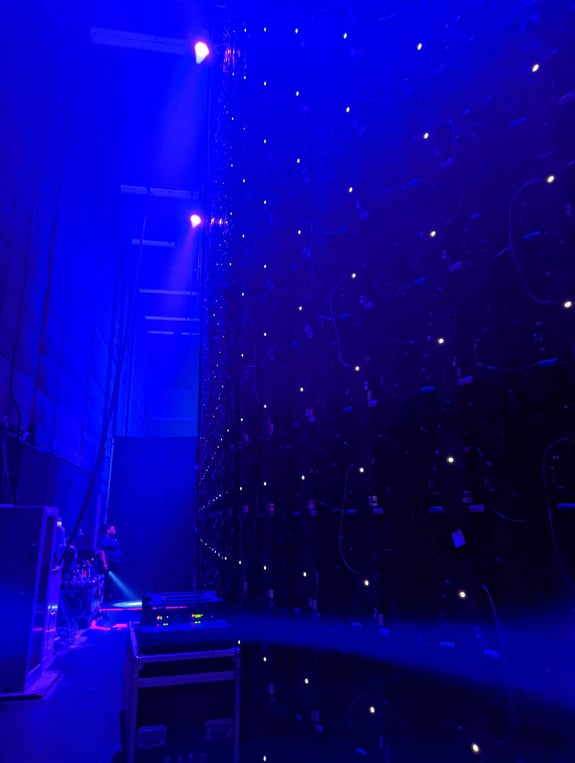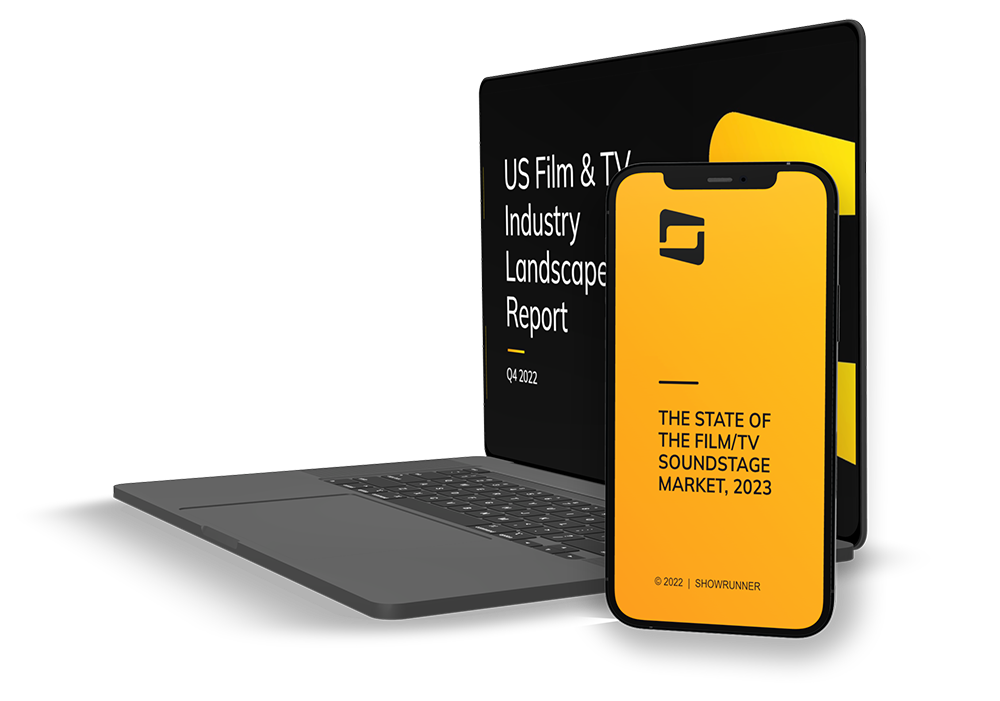
VIRTUAL PRODUCTION GLOSSARY
A guide to the terms & tricks of the high-tech trade that's transforming film & commercial production. Special thanks to Visual Effects Society, the American Society of Cinematographers, Epic Games, and Netflix.
Virtual Production Terms
The opening of a diaphragm through which light passes through a lens on a camera to its objective, either a film negative or a digital sensor...
The nearest and furthest area in focus on a camera lens. Determined by the focal length, aperture, camera-to-subject distance of the lens, camera sensor size, etc.
The field and techniques for measuring, processing, and displaying color accurately.
The ability of a light source, such as a cinema luminaire or an LED wall, to render the color spectrum accurately; units include CRI, SSI, TLCI, and TM30. Current LED volumes have a reduced color rendition when compared to daylight and to incandescent lights.
1. In image processing, the loss of detail of an image in areas whose intensity falls outside of the minimum or maximum range of the capture device. 2. In rendering, the area of a scene which falls outside of the field of view or near/far clipping plane of the virtual camera. 3. In production design, a method used to create cutaway views of a model.
The measurement of where an unfocused point of light becomes a circle passing through a lens onto the film back or digital sensor of a camera. Is a characteristic of the lens’s depth of field. See also Bokeh.
The aesthetic quality of the blur in out of focus areas of an image. Bokeh is often used to make virtual cinematography appear more realistic. See also circle of confusion.
The number of binary digits used to store a value, such as a pixel’s color. Higher bit-depths offer greater accuracy. An 8-bit image can display 256 color values for red, green, and blue, equaling ~16.7 million colors. A 16-bit image raises that number to ~4.3 trillion colors. Some common bit depths in cinematography include 10 and 12-bit.
A luminaire with the ability to toggle between daylight and incandescent color temperatures, as opposed to a full-color luminaire which covers a much broader color spectrum.
The ratio between the width and the height of an image or screen. Some common film/TV production aspect ratios are 1.85(flat), 2.35/2.39(scope/anamorphic), and 16:9.
A process that creates much higher realism by matching animations to desired poses.
The sensation of feeling present in a digital environment.
The portion of the visible spectrum that a display can accurately reproduce or a camera can accurately capture, e.g., Rec.709, DCI-P3, and Rec. 2020.
The process of creating virtual imagery which may incorporate aspects of real-world cinematography. Virtual cinematography can be used to build complete virtual worlds from scratch and manipulate them with real-world input. The process includes all of the visualization phases of a virtual production from previs through live-action shooting and into post
The automated construction of a 3D model triangulated from video. See also photogrammetry.
The portion of the color spectrum a given light source emits. LED panels, due to their use of RGB LED bulbs, have a reduced spectral response compared to full-spectrum cinema lights.
Visible distortion which can appear as lines or wave patterns on camera such as when capturing an LED panel without proper genlock or a camera shutter out of phase with the display’s timing.
The process of lighting a scene before the main production unit arrives in order to facilitate complex setups and maximize the full crew’s efficiency. Can apply to physical production or to prelighting virtual environments as they are developed.
The automated construction of a 3D model asset triangulated from multiple 2D photographs; can also be combined with point clouds derived from LIDAR scans, aka sensor fusion. See also image based modeling.
The perceptual difference in an object’s position when seen from different vantage points.
A system that enables color transforms and image display to be handled in a consistent manner across multiple graphics applications.
A measurement of the light intensity of a display screen. One nit is equal to one candela (one candlepower) per square meter.
An undesirable interference pattern caused by the mismatch between the sensors on a digital camera and a complex, repetitive pattern. E.g. moiré can be caused by focusing a camera directly on an LED screen.
A discrete, integrated device designed specifically for lighting; LED panels create incident lighting but are not designed as luminaires.
A mathematical formula or matrix that acts as a color correction, such as transforming between a RAW camera image and the desired display appearance such as an SDR or HDR monitor.
The presence of unintentional light effects on a given surface, such as the spill from movie lights onto an LED wall.
A virtual light placed on the surface of the volume to assist with lighting the subject, can be any shape, hue, intensity, and opacity.
A survey method that illuminates a target with laser and measures the reflected light via infrared sensors to derive a point cloud; useful as part of asset creation and to capture real-world locations.
Lighting on a subject which is reflected or bounced before reaching the subject; as opposed to incident lighting, which comes directly from a source.
Lighting on a subject which comes directly from a source; as opposed to indirect lighting, which is reflected or bounced before reaching the subject.
The representation of a greater dynamic range of luminosity than is possible with standard digital imaging techniques. HDR images retain detail in a fuller range of lights and darks than standard images.
The measure of the magnification power of a lens, typically given in millimeters; the higher the number, the greater the magnification.
The portion of the world that can be seen at any given moment by a person or camera. For a camera, FOV is measured in degrees and based on the focal length of the lens and the size of the camera’s image sensor or film back.
A control system which enables the remote control of focus, iris, and zoom settings on a camera lens simultaneously.
The mathematical measurement of the aperture of a lens, which determines how much light it lets in and affects exposure and depth of field. A T-stop is the actual measurement of light transmitted through the lens.
A light-interference phenomenon that occurs around high-contrast edges of an object, such as LED screens.
The distance of a 3D object from the camera, real or virtual.
The degree to which an asset resembles its real-world counterpart in texture, lighting, properly weighted animation, etc.; another name for quality.
The digital process of generating an image or video content based on 2D, 3D, and lighting information.
A rendering technique that traces rays from the camera and lights in a scene, simulating how the lights and virtual objects’ materials interact.
A scaled-down file that is used as a stand-in for a higher resolution original.
A form of techvis which uses 3D assets and physical simulation to plan live-action stunts. Also called Action design.
A specialized form of techvis designed to test out safety precautions for complex shots, action design, and on-set mitigation procedures. See also action design and techvis.
A form of visualization which uses 3D assets and physical simulation to plan live-action stunts. Also called safetyvis and stuntvis.
The calculation of real-world accurate physical interactions and collision detection within a real-time engine.
A physical or virtual item which can be interacted with.
The chosen technical approach to the needs of a specific shot or scene. This may include an LED volume, green screen setup, partial set or location.
Where an actor looks during a scene; must match to preserve spatial continuity shot to shot. Eyelines can present a particular challenge in virtual production when characters may be filmed asynchronously or at varying scales.
A section of LED panels built onto a mobile platform for easy repositioning and use as a reflection source and other purposes. Also called roaming panels or roaming walls.
-1.png?width=2539&height=346&name=Transparent%20(2)-1.png)


